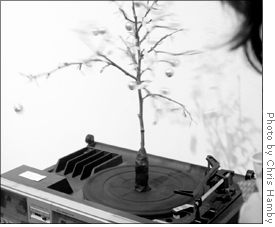
| << Front page | Arts | October 5, 2007 |
Senior Art Proves Theraputic
 How does one go about
searching for foundations in a chaotic
time, a period in history when it seems that things are falling apart? The creation of a visual image has the power to benefit the physical and emotional aspects of both the creator and the viewer. It seems wholly appropriate and fitting that the group senior studio art exhibit now in view in Fisher Gallery was given the title “Group Therapy.” The show, displaying works in progress, opened last Friday.
How does one go about
searching for foundations in a chaotic
time, a period in history when it seems that things are falling apart? The creation of a visual image has the power to benefit the physical and emotional aspects of both the creator and the viewer. It seems wholly appropriate and fitting that the group senior studio art exhibit now in view in Fisher Gallery was given the title “Group Therapy.” The show, displaying works in progress, opened last Friday.
Some of the pieces on display sought to explore intimate and personal matters, while others expressed overt social commentary and concern. The themes of many of the works on display embraced the arts as a method of both healing internal fragmentation and addressing collective distress.
Gabriel Cohen’s multimedia sculpture, “But If You Could, Where Would You Go?,” was a particularly stirring illustration and reminder of the fact that our biosphere has a limited resilience. The display was constructed of a wooden box filled with opaque blue liquid from which strings were emerging out and directly up into the ceiling, as though a wingspread. It was, in part, a testimony to the life of the Laysan Albatross, which is spent primarily at sea.
In his artist’s statement, Cohen urged the viewer to reflect on this “when considering the framework in which we will not exist after the drowning of the planet.”
A tree painted onto the length of one of the gallery’s walls told the story of the Jena six along its trunk. Kantara Souffrant’s “Anyone of Us” confronted the concept of prevailing institutionalized racism in the 21st century — and, as it turns out, startlingly close to home as well. I can’t say that the image of the tree with nooses hanging from it wasn’t as striking as the crucial message it was conveying of the importance of community and solidarity in the quest for social and personal solace. Perhaps the visual display was all too hauntingly familiar, a scene of terror that has been seared over and over on the face of America.
Some artists turned inward, taking on the equally ambitious attempt to conceptualize the self. Marie Barnett’s delicately-crafted interactive booklets professed, quite simply, “This is a book about me.” In one of the miniature booklets sewn into a larger one, she scribbles a quote from Da Vinci, in which he asks “How could you describe this heart in words without filling a whole book?” Perhaps one can’t, but Barnett’s work is an expressive, vivid and lively attempt at one form that a self-portrait can take.
Kelly Lloyd’s self portrait on canvas articulated how she sees herself, while emphasizing the significance of the body and human figure — both her own, and in general — as a vessel for wisdom and learning. Through her own self-perception, she offered an insightful method of chronicling her history and stories. A self-declared “figure painter,” it was particularly interesting to me that Lloyd expressed her deep joy in the actual act of painting and creating art, a therapeutic and healing process as much as the visual product itself.
Also included in the show were works by Jackie Bousek, Laura Einsel, Roni Ginach, Lizzie Harper, Kyla Krug-Meadows, Samantha Mitchell, Fiona Ritter-Davis, Jolie Signorile, Chrissy Spallone, Willie Thurlow, Virginia Wagner and Georgia Wall.
About us
Subscriptions
Advertising
::: Made with CoffeeCup : Web Design Software & Website Hosting :::